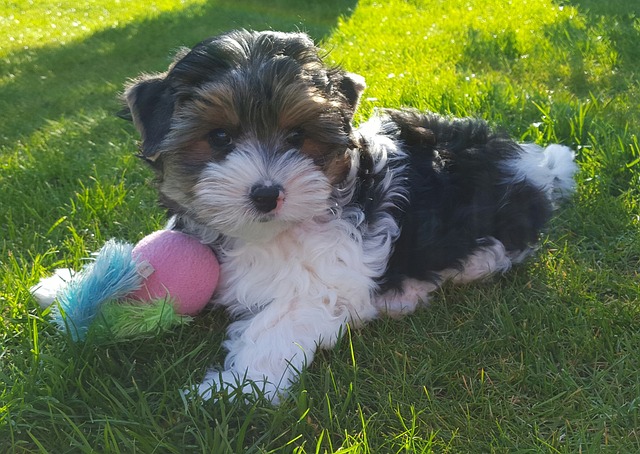When properly groomed and in good health, the long thick coat of the Biewer terriers shed minimally.
This pup is susceptible to much more than just shedding; however, without regular grooming or poor nutrition.
The Biewer Terrier
The Biewer Terrier is a lesser-known breed from breeding two Yorkshire Terriers with the piebald gene.
Although people initially classified the Biewer as a Yorkshire Terrier, in 2007, they were officially recognized as a unique breed.
A loyal and dedicated toy breed, the Biewer is a companion dog and a skilled ratter.
The Biewer Terrier Coat
Although the Biewer derives from the Yorkie, the Biewer has slightly thicker hair and more of it.
The Biewer Terrier has a long single-layer coat with no undercoat; this keeps the fur smooth.
In some Biewers, the hair has a silkier texture, whereas others have a softer texture.
Biewers require regular grooming to avoid matting and tangles, particularly dogs with softer coats, as they are more prone to tangles than dogs with silk coats.
Keeping the Biewer coat in good shape requires daily brushing and full grooming every two to four weeks.
Some owners choose to keep the Biewer coat short, so less frequent grooming is necessary.
Do Biewer Terriers Shed?
The Biewer Terrier has a coat that more resembles human hair than fur. Like human hair, the Biewer terrier’s hair grows in cycles and sheds a small amount at a time year-round.
Other breeds, like the husky, have hair that sheds year-round and is much more noticeable.
So, while Biewer Terriers shed, their shedding is much less noticeable because their hair is thinner, and they shed much less often than other dogs.
How to Stop Your Biewer Terrier From Shedding
Any dog with hair is going to shed, and while there is nothing that you can do to stop a dog from shedding, you can reduce the amount of shedding that they do.
Regular Brushing
Daily brushing helps remove dead and dying hair from the coat, and since the hair adheres to the brush, it is less hair for you to vacuum up from around the house and less hair to irritate allergies!
Regular brushing also stimulates the oil glands in your dog’s skin, which keep the skin moisturized and healthy.
This oil also keeps your dog’s coat looking shiny and well-kept.
As a bonus, regularly brushing your Biewer Terrier’s coat allows you to bond with your dog while checking them for parasites, lumps and bumps, and any other signs of illness or injury.
A Healthy Diet
A healthy diet also plays a significant part in your dog’s shedding pattern and overall feeling of well-being.
A healthy, well-balanced diet ensures that your dog gets all the nutrients they need for its coat to be healthy.
If, however, a dog eats a diet that is not well-balanced or one that is missing essential nutrients, its coat will become dull and may shed more than it should.
Diet concerns that may cause an increase in shedding include:
- Not enough protein.
- Not enough fat.
- Essential fatty acids deficiency.
- Copper deficiency.
- Zinc deficiency.
As a veterinary professional advises, most nutritional deficiencies are treatable with dietary changes and supplementation.
In cases of severe nutritional deficiency, additional treatments may be necessary to relieve more life-threatening symptoms.
Regular Vet Appointments
Maintaining veterinary appointments is crucial for many reasons, but preventative medicine is one of the most important.
Regular visits with the vet ensure that dogs are to date on vaccinations and that illness gets caught as early as possible.
There are a variety of medical conditions and symptoms of medical conditions that can cause increased shedding, including:
- Allergies (environmental, food, dermal reactions.)
- Skin infection.
- Foreign body puncture wounds.
- Pressure sores.
- Hypothyroidism.
- Scleroderma.
- Hormonal imbalances.
- Hormonal shifts (such as a lactating mother would experience.)
- Inflammation and diseases are causing inflammation.
- Fungal infection.
- Pregnancy.
- Malnutrition.
- Ringworm.
- Alopecia post-clipping.
- Cushing’s disease.
- Burns.
- Poisoning.
- Liver disease.
- Cancer.
- Kidney disease.
- Growth hormone disorders.
- Post-neutering hair loss.
- Stress.
- Mange (caused by a parasite.)
Regular Monthly Preventatives
Most people are unaware that monthly preventatives can impact your dog’s skin and coat health, but they can!
Especially fleas!
Many of the parasites that monthly preventatives protect against can cause skin irritation or set off allergies that cause hair loss.
It only makes sense, then, that regular application of preventatives protects against this type of problem.
Treatments For Biewer Terrier Hair Loss
Many causes of hair loss in dogs are easily fixable with lifestyle changes.
For example, hair loss caused by flea allergies is treatable by treating the fleas.
Other causes of hair loss in dogs are less easily treatable and require several tests to confirm a diagnosis.
Some of these conditions can also take a while to treat because vets must find the correct medication dosage before it takes effect.
One of the causes of hair loss that is particularly difficult to treat is an autoimmune disease.
Often an autoimmune disease is only controlled by treating the symptoms and providing preventative and supportive care.
Some autoimmune diseases can be complicated to manage, so it is best to seek a specialty veterinarian to handle these cases.
Conclusion / Summary
The Biewer Terrier is a minimally shedding breed that sheds small amounts of hair year-round.
Since this shedding is in such small amounts, it is barely noticeable to owners, mainly if they maintain a regular brushing and grooming schedule.

